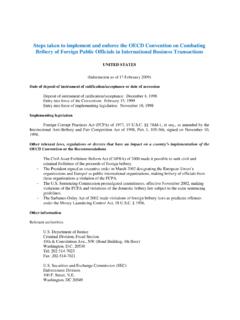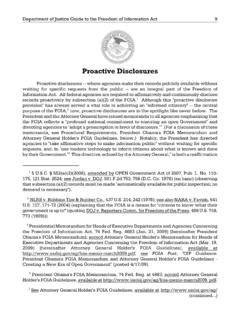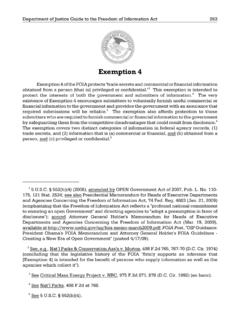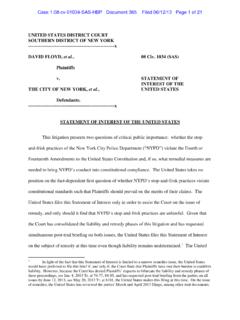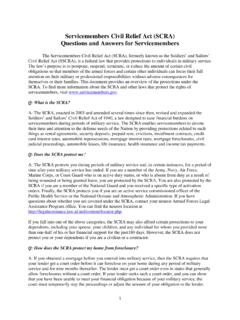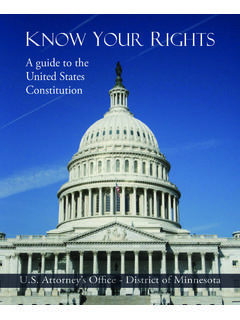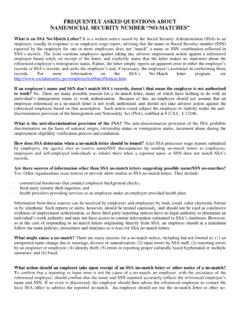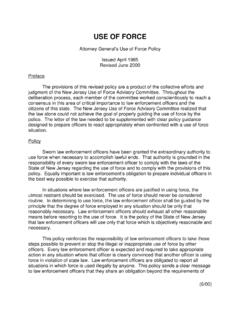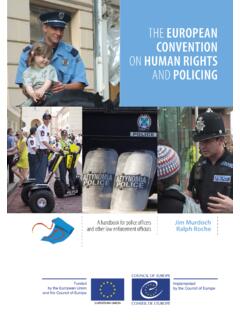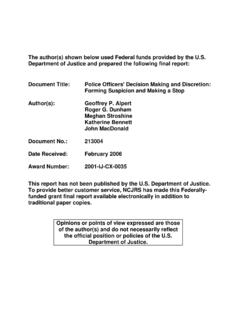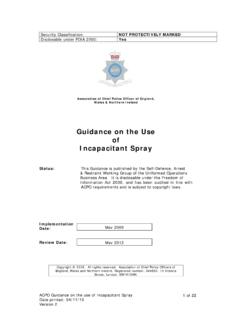Transcription of Implementing a Body-Worn Camera Program - Justice
1 Implementing a Body-Worn Camera ProgramRecommendations and Lessons LearnedImplementing a Body-Worn Camera ProgramRecommendations and Lessons LearnedThis project was supported by cooperative agreement number 2012-CK-WX-K028 awarded by the Office of Community Oriented Policing Services, Department of Justice . The opinions contained herein are those of the author(s) and do not necessarily represent the official position or policies of the Department of Justice . References to specific agencies, companies, products, or services should not be considered an endorsement by the author(s) or the Department of Justice . Rather, the references are illustrations to supplement discussion of the issues. The Internet references cited in this publication were valid as of the date of publication. Given that URLs and websites are in constant flux, neither the author(s) nor the COPS Office can vouch for their current validity. The points of view expressed in this publication do not necessarily reflect the opinions of individual police Executive Research Forum citation: Miller, Lindsay, Jessica Toliver, and police Executive Research Forum.
2 2014. Implementing a Body-Worn Camera Program : Recommendations and Lessons Learned. Washington, DC: Office of Community Oriented Policing : 978-1-934485-26-2 Published 2014 ContentsLetter from the PERF Executive Director ..vLetter from the COPS Office Director ..viiAcknowledgments ..ixIntroduction ..1 State of the field and policy analysis ..1 Project overview ..2 Chapter 1 . Perceived Benefits of Body-Worn Cameras ..5 Accountability and transparency ..5 Reducing complaints and resolving officer-involved incidents ..5 Identifying and correcting internal agency problems ..7 Evidence documentation ..9 Chapter 2 . Considerations for Implementation ..11 Privacy considerations ..11 Determining when to record ..12 Consent to record ..14 Recording inside private homes ..15 Data storage, retention, and disclosure ..15 Lessons learned on privacy considerations ..18 Impact on community relationships ..19 Securing community support.
3 21 Protecting intelligence-gathering efforts ..22 Lessons learned about impact on community relationships ..24 Addressing officer concerns ..24 Officer concerns about Body-Worn cameras ..24 Addressing officer concerns ..26 Incremental implementation ..27 Lessons learned about addressing officer concerns ..27 Managing expectations ..28 Officer review of video prior to making statements ..29 Lessons learned about managing expectations ..30 Financial considerations ..31 Cost of implementation ..32 Cost-saving strategies ..33 Lessons learned about financial considerations ..34 Chapter 3 . Body-Worn Camera Recommendations ..37 General recommendations ..38 Recording protocols ..40 Download and storage policies ..42 Recorded data access and review ..45 Training policies ..47 Policy and Program evaluation ..48 iv Implementing a Body-Worn Camera Program : Recommendations and Lessons LearnedConclusion ..51 Appendix A.
4 Recommendations Matrix ..53 Policy recommendations ..53 General recommendations ..53 Recording protocols ..55 Download and storage policies .. 59 Training policies ..65 Policy and Program evaluation ..66 Additional lessons learned: engaging officers, policymakers, and the community ..67 Appendix B . Conference attendees ..69 About PERF ..77 About the COPS Office ..79 Letter from the PERF Executive DirectorThe recent emergence of Body-Worn cameras has already had an impact on policing, and this impact will only increase as more agencies adopt this technology . The decision to implement Body-Worn cameras should not be entered into lightly . Once an agency goes down the road of deploying Body-Worn cameras and once the public comes to expect the availability of video records it will become increasingly difficult to have second thoughts or to scale back a Body-Worn Camera Program .A police department that deploys Body-Worn cameras is making a statement that it believes the actions of its officers are a matter of public record.
5 By facing the challenges and expense of purchasing and Implementing a Body-Worn Camera system, developing policies, and training its officers in how to use the cameras, a department creates a reasonable expectation that members of the public and the news media will want to review the actions of officers . And with certain limited exceptions that this publication will discuss, Body-Worn Camera video footage should be made available to the public upon request not only because the videos are public records but also because doing so enables police departments to demonstrate transparency and openness in their interactions with members of the community . Body-Worn cameras can help improve the high-quality public service expected of police officers and promote the perceived legitimacy and sense of procedural Justice that communities have about their police departments . Furthermore, departments that are already deploying Body-Worn cameras tell us that the presence of cameras often improves the performance of officers as well as the conduct of the community members who are recorded.
6 This is an important advance in policing . And when officers or members of the public break the law or behave badly, Body-Worn cameras can create a public record that allows the entire community to see what really happened .At the same time, the fact that both the public and the police increasingly feel the need to videotape every interaction can be seen both as a reflection of the times and as an unfortunate commentary on the state of police -community relationships in some jurisdictions . As a profession, policing has come too far in developing and strengthening relationships with its communities to allow encounters with the public to become officious and legalistic . Body-Worn cameras can increase accountability, but police agencies also must find a way to preserve the informal and unique relationships between police officers and community members .This publication, which documents extensive research and analysis by the police Executive Research Forum (PERF), with support from the U.
7 S . Department of Justice s Office of Community Oriented Policing Services (COPS Office), will demonstrate why police departments should not deploy Body-Worn cameras carelessly . Moreover, departments must anticipate a number of difficult questions questions with no easy answers because they involve a careful balancing of competing legitimate interests, such as the public s interest in seeing Body-Worn Camera footage versus the interests of crime victims who would prefer not to have their images disseminated to the world .One of the most significant questions departments will face is how to identify which types of encounters with members of the community officers should record . This decision will have important consequences in terms of privacy, transparency, and police -community relationships . Although recording policies should provide officers with guidance, it is critical that policies also give officers v vi Implementing a Body-Worn Camera Program : Recommendations and Lessons Learneda certain amount of discretion concerning when to turn their cameras on or off.
8 This discretion is important because it recognizes that officers are professionals and because it allows flexibility in situations in which drawing a legalistic bright line rule is impossible . For example, an officer at a crime scene may encounter a witness who would prefer not to be recorded . By using discretion , the officer can reach the best solution in balancing the evidentiary value of a recorded statement with the witness s reluctance to be recorded . The decision may hinge on the importance of what the witness is willing to say . Or perhaps the witness will agree to be recorded by audio but not video, so the officer can simply point the Camera away from the witness . Or perhaps the witness will be willing to be recorded later, in a more private setting . By giving officers some discretion , they can balance the conflicting values . Without this discretion , Body-Worn cameras have the potential to damage important relationships that officers have built with members of the community.
9 This discretion should not be limitless; instead, it should be guided by carefully crafted policies that set specific parameters for when officers may use discretion .If police departments deploy Body-Worn cameras without well-designed policies, practices, and training of officers to back up the initiative, departments will inevitably find themselves caught in difficult public battles that will undermine public trust in the police rather than increasing community support for the police .This publication is intended to serve as a guide to the thoughtful, careful considerations that police departments should undertake if they wish to adopt Body-Worn cameras .Sincerely, Chuck Wexler, Executive Director police Executive Research ForumLetter from the COPS Office DirectorDear colleagues,One of the most important issues currently facing law enforcement is how to leverage new technology to improve policing services . Whether using social media to engage the community, deploying new surveillance tools to identify suspects, or using data analysis to predict future crime, police agencies around the world are Implementing new technology at an unprecedented pace.
10 Body-Worn cameras, which an increasing number of law enforcement agencies are adopting, represent one new form of technology that is significantly affecting the field of policing . Law enforcement agencies are using Body-Worn cameras in various ways: to improve evidence collection, to strengthen officer performance and accountability, to enhance agency transparency, to document encounters between police and the public, and to investigate and resolve complaints and officer-involved incidents . Although Body-Worn cameras can offer many benefits, they also raise serious questions about how technology is changing the relationship between police and the community . Body-Worn cameras not only create concerns about the public s privacy rights but also can affect how officers relate to people in the community, the community s perception of the police , and expectations about how police agencies should share information with the public.

